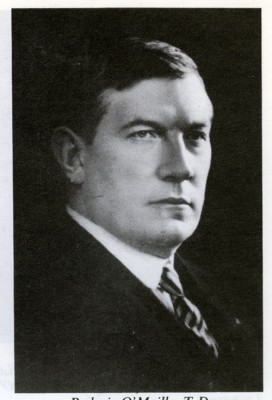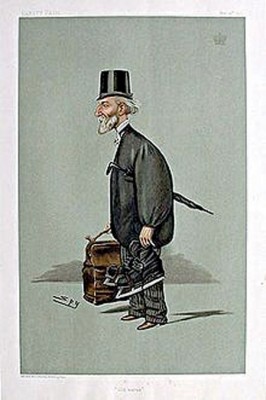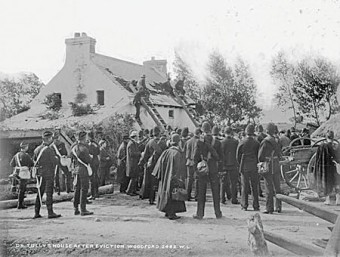Search Results for 'Irish Parliamentary Party'
12 results found.
What Irish political parties can learn from the UK election

While last week's historic referendum on same sex marriage was undoubtedly the political event of the year in Ireland, earlier this month the eyes in Leinster House were very firmly fixed on events across the Irish Sea and the British general election.
Was James Hack Tuke the Oskar Shindler of his day?
A surprising rescuer of the Tuke assisted emigration scheme from the west of Ireland came from the London government. After the first group of 1,315 people had sailed from Galway for America on April 28 1882, the Tukes’ emigration fund was practically exhausted. Yet the demand for places grew each day. Now more than 6,000 applications, mainly from the Clifden area, but also from Belmullet, Newport and Oughterard, poured into the Clifden union where James Hack Tuke had his office. While poverty and famine remained endemic in the west of Ireland, people with spirit must have felt that the day-to-day grind was never ending. The threat of another Great Famine was very real. They wanted a new life.
The Land War: A desperate duel between Parnell and Forster

The continued unrest, murders, and large-scale protests as the Land War careered dangerously through the Irish countryside, led at last to some reform. William Gladstone’s Second Land Act of 1881 proposed broad concessions to the tenant farmer. But Parnell, the very effective leader of the Irish Parliamentary Party, was not satisfied. He said that tenants were still vulnerable to rent arrears and poverty resulting from poor harvests. He urged that the Act either accommodate these concerns, or be rejected.
Fianna Fáil - the greatest comeback since Lazarus?

Over recent weeks, despite the happy distraction of the St Patrick’s Day festivities and the Easter break, Insider has detected a sense of worry in people’s demeanour created by a largely unexpected development that has truly shaken them out of any complacency.
‘ Prepared to fight and to die’ for Ireland

The general election of 1918 was also a plebiscite on the Easter Rising, two years previously. The Rising, and the destruction of the centre of Dublin, had been generally condemned. The Irish Parliamentary Party, under John Redmond, had been inching towards Home Rule; why bother with such violence? The belief was that the men and women of 1916 were brave, if foolhardy. Yet following the prolonged executions of the leaders, the massive round up of participants, and their imprisonment in Britain, a change of attitudes swept the country. This was perfectly illustrated in the election held on a bleak December day 1918. Sinn Féin had fielded candidates in every constituency. The campaign was vigorous and tough.
The case of the Craughwell Prisoners
In the 1880s the Land War was at its height. It was a prolonged period of bitter civic unrest which pitted an unprotected peasantry against some ruthless landlords, who had the law and power of eviction at their disposal. Following the Great Famine a weakened tenant peasantry was easily removed from the land. It began a pitiful trail to the workhouse, and the emigrant ships. But as the century progressed the situation changed. The highly organised Irish National Land League supported evicted farmers; while members of the Irish Parliamentary Party in Westminster fought for legislation which would eventually see a redistribution of land to tenants.
Extraordinary victory for the people of east Galway

Between 1869 and 1909 a revolution took place in land ownership in Ireland. A succession of Land Acts gradually reduced the powers of the landlord, and gave their former tenants the means and the opportunity to buy out their tenancy, and to own their own farms. Generous terms were given to tenants by the Wyndham Act of 1903. £100 million was advanced for land purchase, which was immediately availed of by the great majority of tenants. Tenants were advanced the whole purchase price of their holding, at a little over three per cent to be repaid over 68 years. Most landlords were pleased to accept the ready cash, and a whole new social structure emerged throughout the island. However, initially landlords were not compelled to sell, and the independently wealthy marquis of Clanricarde of east Galway refused to cooperate. But his days of evictions, disparaging remarks about his tenants, his bully boy land agent Edward Shaw Tener and his henchmen, were numbered.
Fear and loathing in east Galway

Following the extensive publicity and extraordinary use of more than 700 military, police, emergency men and bailiffs, to evict five families from the marquis of Clanricarde’s estate, the people of Woodford and all of east Galway were in a state of shock, anger and fear. It was now clear that Clanricarde would use every method within his considerable powers to evict any of his tenants who refused to pay their rent. Despite pleas for a rent reduction because of successive bad weather, he refused to even consider it. He scoffed at John Dillon’s Plan of Campaign, supported by the Land League, which urged tenants to stick together, and to refuse to pay unreasonable rent.
The Maamtrasna Murders, August 17 1882

Early on Friday August 18 1882, John Collins, a tenant farmer, having heard disturbances during the night coming from his neighbours’ house, the Joyces, went to check if all was well. He must have feared the worst because he brought with him two neighbours, Mary and Margaret O’Brien. They discovered an appalling sight. Even today, when our senses have been hardened by so many atrocities, it was a scene of savage murder that cried to heaven. No mercy was shown to this unfortunate family.

